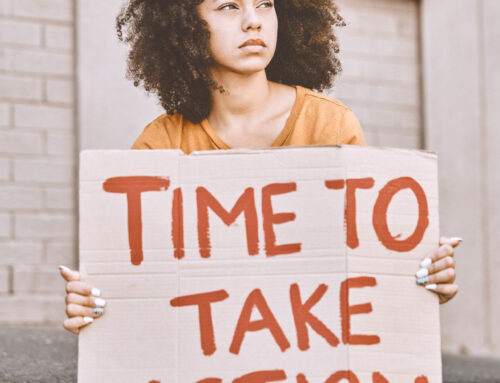In days following the murder of George Floyd . . . I had no words.
This is unusual for me as a journalist, speaker, leadership team member of an advocacy-based nonprofit, and downright talkative person.

My nonprofit wanted to put out a statement. Freelance news stories [demanding a Black perspective] awaited. And then there was the white cashier who decided I “looked tired.” I felt pressured to say something important.
Yet my responses to “How are you doing?” have ranged from “Slightly better than numb” to “Stop killing us.”
What became important, in my awkward days of silence, was that nonprofits are in a unique position to offer help, healing, and hope.
Nonprofit voices are leading the way to change with thoughtful pieces about institutional racism, White supremacy and White privilege.
And yes, I know that some of us are just out here unsure about what to say or do.
So without preaching to the choir, coddling, or providing a history lesson, I’ve divided nonprofit responses into these categories:
- Silence
- Statements
- Solidarity
Let’s see what’s helpful and what’s just adding to the noise or even hurting.
Let’s Start with Silence
At such a time as this, even silence says something, especially if you are a white-led organization. “Colorblind” posts and statements are being interpreted by your audience. This was echoed in statements published by nonprofit leaders in the Chronicle of Philanthropy.
In “Silence Is Consent,” Kimberly Perry, Executive Director of the DC Action for Children, unpacks the notion of silence through the eyes of children:
“Many white parents avoid talking about race, particularly with their kids. They might believe that leading by example, with kindness and compassion, is enough. It is not enough. Children and young people deserve to unpack and understand their privilege in society. On the other hand, parents of color are forced to have the conversation with their children, over and over and over. Conversations about racism are vital for all families. Without conversation, our kids see silence and are themselves ill equipped to confront racism. And silence is consent.”
Kimberly Perry
Her sentiments about silence are echoed by many in this conversation.
This is a good time to talk within your organization about “silence” in your camp. If you are quiet because you do not understand statements like Perry’s…then you will need to seek more than THIS blog post for help.
But is there a place for silence?
I shared this question with my friend Kim Pevia. Kim coaches organizations around the nation on topics of racial equity and social justice and she recently received Ava DuVernay’s Array award as director of the Lumbee Film Festival.
Her advice is that there is a time to “Listen and Be Silent.”
Sometimes silence is the right thing. Because being tone-insensitive is worse than silence . . .
Two nonprofit emails in particular made me wish that people would stop trying so HARD to be a part of this painful conversation.
One nonprofit sent an email comparing Congress’s failure to pass the Equal Rights Amendment to “putting the knees in the necks of women.” A local humane society compared the mistreatment of Black people in custody of law enforcement to the mistreatment of animals. Both are incredibly tone-insensitive.
Here’s Kim’s advice: “You don’t have to speak all of the time. You don’t have to post something on social media that points to how woke you are.”
You are lovely (in most cases) and you have also had the microphone for a very long time. It will be good to give the microphone to someone else who is living a different experience than your own. “Share the megaphone.”
Check this perfect example: Steven Shattuck at Bloomerang Tech dropped the proverbial mic on Twitter earlier this week.

Steven goes on to talk about the shift in editorial content in a series of tweets.
“We have 119,353 blog subscribers and 12,880 social followers. That megaphone now belongs to #BIPOC working in the nonprofit sector. You have an open invite to write for our blog (PAID!) and elevate your voice. I have cleared our editorial calendar.” 2/
“#BIPOC working in the nonprofit sector have something to say and we want to give them a platform. You will only occasionally hear from them at conferences and in industry publications. If you have a story, opinions or thoughts to share, I will publish it, and pay you.” /3
“Secondly, we have created https://bloomerang.co/dei/ to be a living library of resources dedicated to furthering diversity, equity, and inclusion (DEI) in the nonprofit sector. Submissions are welcome.” 4/
Steven and Bloomerang took white “silence” to a whole new (hopeful) level.
Along Comes the Flood of Statements
Statements often share a clear stance on care for and affirmation for Black people. This will not be appropriate for every nonprofit. Start by asking if your organization is ready for this. Don’t do this in silos. When releasing a statement, the entire organization must be prepared for questions, feedback, and pushback.
For examples, check out the growing resource guide that Julia Campbell and others are filling with powerful nonprofit statements.
Here are a few tips that Kim and I put together for those of you wishing to make statements:
- Say Their Names. George Floyd is one of the most recent police killings of many other unarmed Black people including Breonna Taylor, Ahmaud Arbery, and Tony McDade. There are so many more Black people who have lost their lives senselessly.
- Take it Personally. What have you learned? How does racism impact those you serve? How is your organization responding?
- Call it Racism. Do not soften the intensity of systemic racism with broad language about diversity, equity, and inclusion. If the statement does not include words such as “racism,” “racist,” “White supremacy,” or “anti-Blackness,” don’t bother.
- Call for Action. If you are writing sincerely, your audience and supporters will want to know what to do next. If you don’t have an answer within your mission, consider diverting fundraising to a local Black-led organization or supporting directly involved groups.

Last, but not least. Don’t use Black Lives Matter in your statement, hashtag, or anything that resembles the movement to RAISE MONEY . . . unless you’re truly fundraising for BLM.
Are You Ready for Solidarity?
Dear Allies:
This is a real fire . . . it is not a drill.
It’s not cute to use the term “In Solidarity” in statements and email signatures unless you are ready to carry the burden.
Throughout this entire COVID-19 crisis, Kishshana Palmer’s Rooted Collaborative has been giving me life. *BIPOC Women, this is a healing space.*
She was quiet for a few days, but recently sent an update that best describes how your Black ED/Donor/Volunteer/Client/Comms Director might be feeling.
Kishshana gave permission for me to share her post.
“I am under siege. At home with blinds closed and doors triple locked; phones always charged and a ‘go’ bag packed. At work battling being undermined and overlooked…” she wrote. “Time and time again I have learned through hard lessons that my life — black people’s lives — can be taken at the hands of law enforcement or a ‘well meaning’ coworker and if I live…maimed by the bloody blows of racism so pervasive… so deep-seated that it sits in the air stale like a house that hasn’t opened the windows in years.”
Kishshana Palmer
This is why commitments to solidarity will be taken seriously. We’re talking heavy lifting.
If you are writing statements in solidarity, include steps such as:
- Critical anti-racism training and self-reflection
- Diverting resources/attention to Black-led organizations
- Condemning oppressive systems that cause to harm black people, and acknowledging harm that you’ve caused.
If any of those make you queasy…then you’re not ready for solidarity [See Silence above].
We are not all “in this together” because some of us are under attack at alarming rates. But we can get through this together.






